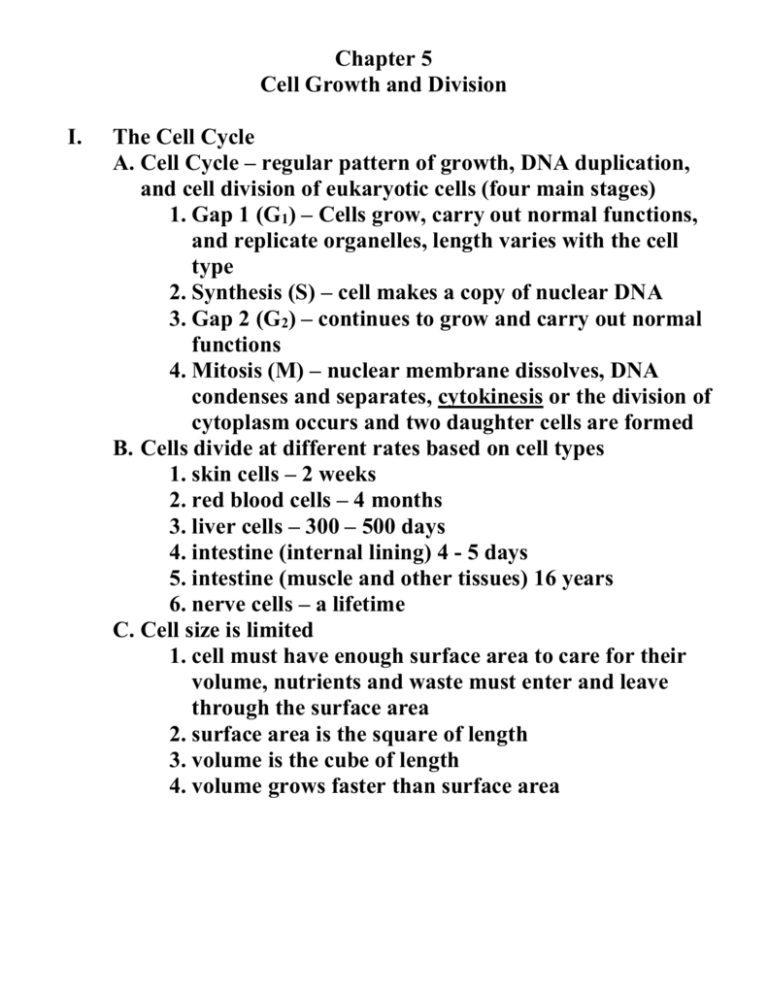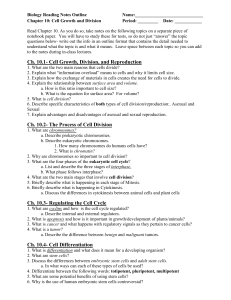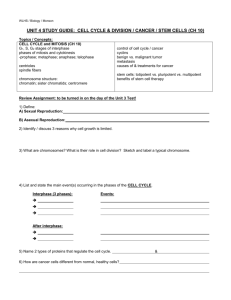Chapter 5
advertisement

Chapter 5 Cell Growth and Division I. The Cell Cycle A. Cell Cycle – regular pattern of growth, DNA duplication, and cell division of eukaryotic cells (four main stages) 1. Gap 1 (G1) – Cells grow, carry out normal functions, and replicate organelles, length varies with the cell type 2. Synthesis (S) – cell makes a copy of nuclear DNA 3. Gap 2 (G2) – continues to grow and carry out normal functions 4. Mitosis (M) – nuclear membrane dissolves, DNA condenses and separates, cytokinesis or the division of cytoplasm occurs and two daughter cells are formed B. Cells divide at different rates based on cell types 1. skin cells – 2 weeks 2. red blood cells – 4 months 3. liver cells – 300 – 500 days 4. intestine (internal lining) 4 - 5 days 5. intestine (muscle and other tissues) 16 years 6. nerve cells – a lifetime C. Cell size is limited 1. cell must have enough surface area to care for their volume, nutrients and waste must enter and leave through the surface area 2. surface area is the square of length 3. volume is the cube of length 4. volume grows faster than surface area II. Mitosis and Cytokinesis A. Chromosomes condense at the start of mitosis 1. Chromosome – long continuous thread of DNA that consist of numerous genes and regulatory information 2. Human cells have 23 pairs of chromosomes or a total of 46 3. During interphase DNA is loosely organized (unwound) 4. Chromosomes are associated with a group of proteins called histones 5. Chromatin – the loose combination of DNA and histones 6. Chromatid - one half of a duplicated chromosome 7. Sister chromatids are held together by a centromere B. Mitosis and cytokinesis produce two identical daughter cells 1. Mitosis divides a cell’s nucleus into two identical nuclei (mitosis has four stages) a. prophase – chromatin condenses into tightly coiled chromosomes, the nuclear envelope breaks down, the nucleolus disappears, centrosomes and centrioles migrate to opposite sides of the cell b. metaphase – spindle fibers attach to centromeres and chromosomes line up across the middle of the cell c. anaphase – sister chromatids separate and spindle fibers pull the chromatid to opposite ends of the cell d. telophase - nuclear membrane forms, chromosomes begin to uncoil, spindle fibers fall apart 2. Cytokinesis – cytoplasm divides into two cells, the cell membrane pinches and completes the cell cycle C. Single cell organisms use mitosis as a means of reproduction III. Regulation of the Cell Cycle A. Internal and external factors regulate cell division 1. External Factors a. physical signals – cell contact, crowding b. chemical signals – growth factors, example: erythropoietin stimulates the growth of red blood cells, growth hormones 2. Internal factors a. Kinases – enzymes that transfer a phosphate group from one molecule to a target molecule b. Cyclins – activate kinases 3. Apoptosis – programmed cell death, (webbed fingers and toes of embryos) B. Cancer – uncontrolled cell division 1. benign – cancer tumor where the cancer cells stay clustered together 2. malignant – cancer tumor in which cells break away and spread to other parts of the body 3. metastasize – to spread by transferring a diseasecausing agent from one site of the disease to other parts of the body 4. Cancer cells are harmful because they do not perform a specialized function needed by the body, they require lots of food and a hearty blood supply, crowding caused by the tumor damages normal cells 5. Carcinogens – substances that produce or promote the development of cancer a. Radiation (example: ultraviolet light) b. Chemicals (example: tobacco smoke, pollutants, BPA) c. Viruses (example: HPV causes cervical cancer) 6. treatment of cancer – radiation and chemotherapy IV. Asexual Reproduction – the creation of offspring from a single parent and does not involve the joining of gametes A. Binary Fission – asexual reproduction of a single-celled organism by division into two roughly equal parts 1. Steps of binary fission a. bacterial chromosomes duplicate b. as cell grows, chromosomes move away from each other c. cell undergoes cytokinesis d. membrane pinches inward and a new cell wall is laid down between chromosomes e. two daughter cells are formed 2. Advantages and disadvantages of asexual reproduction a. Advantages 1) more efficient in favorable environments 2) all organisms can reproduce 3) no time and energy used finding a mate b. Disadvantages 1) no diversity , hard to adapt in changing conditions B. Some eukaryotes reproduce through mitosis (asexually) 1. new plant from a stem cutting 2. budding – hydras 3. fragmentation – flatworms, seastars 4. vegetative reproduction – new offspring growing up from “runners” C. Many organisms reproduce sexually and asexually, depending on the conditions V. Multicellular Life A. Multicellular organisms depend on interactions among different cell types 1. organization of multicellular organisms cellstissuesorgansorgan systemsorganism a. tissues – groups of cells that work together to perform a particular function b. organs – groups of tissues that work together to perform a specific function c. organ systems – group of organs that work together to perform a particular function d. organism – collection of organ systems that work together for the good of the whole organism B. Cells specialize 1. cell differentiation – process by which specialized cells develop into their mature forms and function 2. a cells location in the embryo helps determine how a cell will differentiate C. Stem cells develop into different cell types 1. Stem cells have the ability to: a. divide and renew themselves for long periods of time b. remain undifferentiated in form c. develop into a variety of specialized cell types 2. Stem cell classification a. Totipotent stem cells can grow into any other cell type. Only fertilized eggs and the cells produced by the first few divisions of an embryo are totipotent b. Pluripotent stem cells can grow into any cell type except for totipotent stem cells c. Multipotent stem cells can only grow into cells of closely related cell families 3. Adult stem cells – partially undifferentiated cells located among the specialized cells of many tissues and organs. They can be taken from the patient and put back into them with risk of rejection 4. Embryonic stem cells – come from donated embryos grown in a clinic 5. Stem cells give hope for the growing of tissues and organs to replace worn out or damaged tissues or organs.







